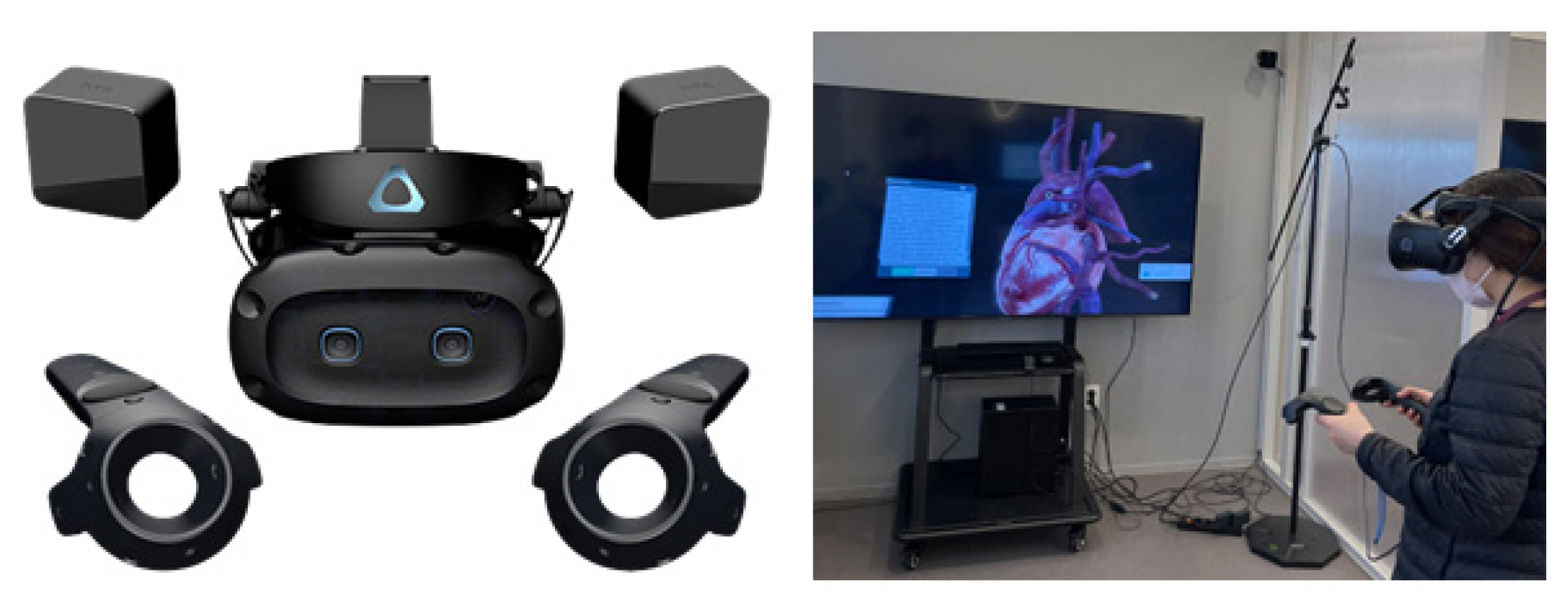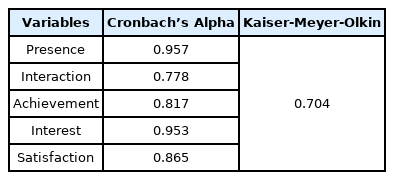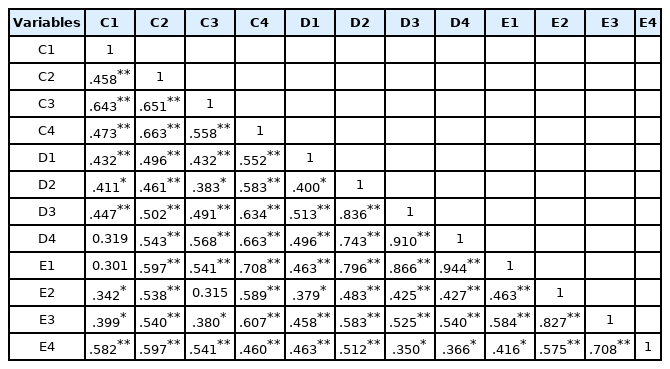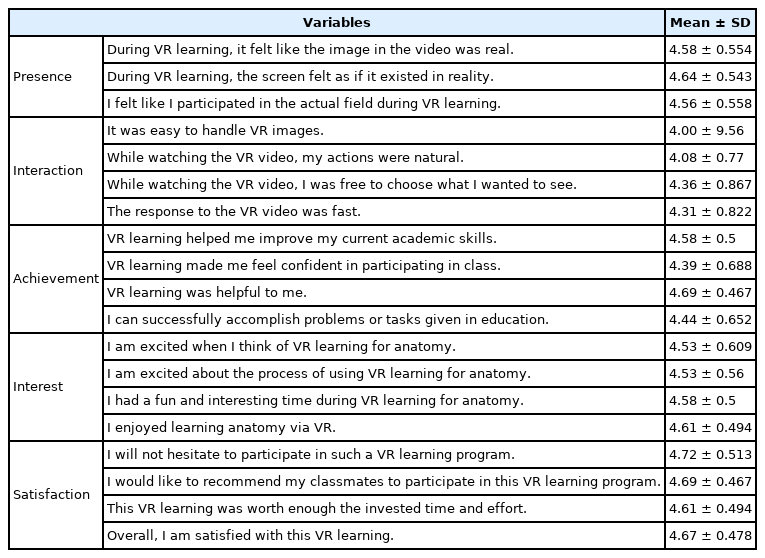An Analysis on the Application of a Virtual Reality Program in the Basic Medicine Subject Class for Training of Students in Emergency Medical Services
Article information
Abstract
This study was conducted to enable severity classification according to symptoms and signs appealed by the emergency medical services based on the patient's anatomical structure in the field and to study the effective method of teaching anatomy classes required to apply first aid. Therefore, this study attempted to employ practice using virtual reality in anatomy classes, understand the learning effects, and provide basic data on the use of class media using virtual reality in order to improve the quality of anatomy classes in the future. As a result of the study, the theoretical understanding showed a statistically significant difference (p < 0.001), and class satisfaction was statistically significantly higher after applying virtual reality (p < 0.001). It is believed that if a virtual reality-based education program is applied to enhance the learning effect in anatomy classes, it will have an educational effect on students.
1. Introduction
Human anatomy is a fundamental course that teaches the structures and functions of the complex human body, and the knowledge on this subject is vast. To facilitate efficient learning in an anatomy course, systematic teaching as well as cadaver dissection in which anatomy lab is taught based on theoretical classes should be offered [1,2]. However, due to accessibility and ethical issues, it is difficult to offer cadaver dissection labs to medical students and students in public health-related fields [3]. On the other hand, students in fundamental medical science courses (including anatomy) express difficulties in learning due to the immense volume of medical terms and contents regarding human body structures and functions that they need to memorize [4]. Recently, there was chaos regarding in-person teaching due to the rapid spread of the coronavirus disease (COVID-19) [5]. Therefore, educational institutes are using new educational media developed to replace cadaver dissection [6,7]. Some studies have reported that the learning effect was better in anatomy classes which used visual effects to aid understanding of the organs in the human body compared to that in theory-focused classes [8,9]. Since the 1980s, studies conducted on the effect of virtual reality (VR) in a variety of educational media report that the use of VR in education, in particular, could increase student involvement, real-time interaction, and creativity [10,11]. VR is a technology that creates 3D visualization using a computer to provide users with dynamic reality and the opportunity for multifaceted interaction [12]. In fact, VR-based educational programs have already been applied in several disciplines including clinical medicine, emergency medal science, nursing, and special education [13-16]. Recent advancements in computer technology enabled digital anatomy simulation in a different format [17,18], and realistic and scalable digital simulation has been used in anatomy classes. VR appears to be the most useful and effective educational tool as anatomical structures in the human body are visualized using a headset, which helps enhance student involvement due to a realistic sensation [19]. In Korea, however, reports on the application of various educational media in basic medical science classes are lacking. Most emergency medical service personnel in the field work as emergency medical technicians (EMT) at the 119 Safety Call Service under the Korean National Fire Agency. In the field, patient assessment is critical, and prompt and accurate first aid greatly impacts patient life and prognosis. Among the EMT tasks in the field, in particular, airway management and first aid, joint bracing and spinal stabilization, hemostatic dressing for external bleeding, wound treatment, and CPR can be performed effectively, only if the EMT understands anatomical locations and structures. Emergency medical service training of the Korean National Fire Agency consists of training of new employees and EMT courses. Because the jobs in the fire department are directly linked to life and safety, it is essential to have practical competence to perform first aid in an emergency situation that may occur on the job, even though the primary task is not emergency medical service. The focus of currently offered courses is on individual clinical subjects; therefore, human anatomy should be added. It is challenging to teach individual clinical subjects and anatomy to trainees who have limited time for practical training in emergency medical science and insufficient knowledge of the fundamentals of medical science. Therefore, selectivity and focus are required in teaching basic medical science courses like anatomy. Moreover, the fundamental knowledge they require to perform the job, particularly regarding the circulatory, respiratory, nervous, and musculoskeletal systems, the knowledge of which is essential in the assessment and treatment of severe patients, must be focused on first. Accordingly, this study aimed to employ VR in the anatomy lab to teach the structure and location of the heart, an organ in the circulatory system, and investigate the learning effect by assessing student satisfaction, achievement, interest, etc. An additional purpose of the study was to provide basic data for improving the quality of anatomy classes and utilizing VR as an educational medium in the future.
2. Method
2.1 Design
2.1.1 Study purposes
This study aimed to apply a VR-based educational program in an anatomy course among the fundamental medical science courses to train EMTs and assess students' comprehension, satisfaction, and learning effect of the program.
2.1.2 Subjects
The subjects were first year students in the department of paramedic science taking an anatomy course from September 3 to December 13, 2021, during which they attended lectures on the circulatory systems and performed a VR-based lab on the circulatory systems after they learned to operate VR instruments. The study subjects included 36 students. They were informed of the study purposes, and they voluntarily consented to study participation.
2.1.3 Research instruments
(1) Instruments used to implement VR
To implement precise and free movements of the heart in VR, Steam VRTM HTC VIVE®, a Microsoft Windows® based program, was used. A 3.5 m * 3.5 m VIVE Elite headset and VIVE controllers in a 15 m2* -sized space were used to support student involvement and the sensation of reality (Figure 1).
(2) VR-based educational program
To help students understand anatomical concepts, Sharecare YOU VR® was used. Compared with other VR anatomy programs, Sharecare YOU VR® provided better visualization of the human body and had an added feature of audio dubbing (e.g., heartbeats), thus enhancing student involvement. The anatomy application program can show 3D visualization of a total of 15 organs, including blood vessels, in 360 degrees (Figure 2).
(3) Survey
A survey instrument used in a previous study[20] was revised appropriately for the current study. It consisted of 3 items regarding presence; 4, interaction; 4, achievement; 4, interest; and, 4, satisfaction. All items were in a 5-point Likert scale with anchors ranging from "not at all" to "very much." The higher the score, the higher the level of achievement, satisfaction, etc. To assess item reliability, Cronbach alpha values were calculated.
(4) Definition of the terms
In this study, presence, interaction, achievement, interest, and satisfaction were defined as follows.
-Presence: a psychological experience in which the student has a sensation that VR-based simulation feels real, and, the student is immersed into the situation presented in VR
-Interaction: the ease of using the instruments of the VR-based educational program and the awareness of immediate response
-Achievement: the perception that the VR-based educational program is effective for learning and helps improve academic performance
-Interest: the feelings of pleasure and interest while studying with the VR-based educational program
-Satisfaction: satisfaction with learning through the VR-based educational program
2.1.4 Data analysis
Data analysis was performed using SPSS software 18.0 (SPSS Inc., USA). Means, standard deviations, and minimum and maximum values were computed by conducting a frequency analysis. To examine the levels of comprehension and satisfaction in traditional theoretical classes and VR-applied classes, a t-test was performed. A p value less than 0.05 was interpreted as statistically significant. Pearson correlation coefficients were computed to examine correlations between the primary variables. To assess sampling adequacy for factor analysis, the Kaiser-Meyer-Olkin (KMO) test was performed.
2.2 Results
2.2.1 Demographic characteristics of study subjects
Subjects' demographic characteristics are shown in Table 1. Of the 36 subjects, 16 (44.5%) were male and 20 (55.5%) were female. The mean age was 20.4 years. Thirteen (36.1%) subjects had previous experience with VR once or more.
2.2.2 Comparisons of the comprehension of the circulatory system and satisfaction pre and post the VR-based educational program
The results of the analysis of the levels of comprehension and satisfaction before and after the application of the VR-based educational program are presented in Table 2. The scores for theoretical comprehension of the circulatory system before and after the program were 3.69 and 4.42, respectively, and the difference was statistically significant (p < 0.001). The satisfaction scores were 3.92 and 4.64 before and after the program, and this difference was also statistically significant (p < 0.001).
2.2.3 Item reliability testing
The results of item reliability testing are presented in Table 3. Cronbach alpha values were α = 0.957 in the items regarding presence, α = 0.778, interaction; α = 0.817, achievement; α = 0.953, interest; and, α = 0.865, satisfaction. The value of KMO statistic (0.704), calculated to assess sampling adequacy for factor analysis, was over 0.5, suggesting that the data had sufficient explanatory power.
2.2.4 Correlations between interest, achievement, and satisfaction
Table 4 shows correlations between the variables of interest, achievement, and satisfaction in the classes in which VR was applied. Overall, the correlations were positive and statistically significant. In particular, item C4 among the items regarding achievement showed strong, positive correlations with all the items regarding interest (r = 0.552, r = 0.583, r = 0.634, r = 0.663, p < .001), and satisfaction (r = 0.708, r = 0.589, r = 0.607, r = 0.46, p < .001). Of the items regarding satisfaction, E1 in particular was highly positively correlated with all the items regarding interest (r = 0.463, r = 0.796, r = 0.866, r = 0.944, p < .001).
2.2.5 Analyses of presence, interaction, achievement, interest, and satisfaction
Presence, interaction, achievement, interest, and satisfaction scores based on respective sets of 5-point Likert scale items are presented in Table 5. All items regarding presence, achievement, interest, and satisfaction scored 4.5 points or higher, whereas all items regarding interaction scored lower than 4.5.
3. Conclusions and Discussion
This study examined student satisfaction, achievement, interest, etc. in VR-based classes on the circulatory system during an anatomy course. Satisfaction and interest increased in the classes when VR was applied compared to that in the conventional theory-based classes. Student satisfaction is an important index in the evaluations of learning effect and teaching quality improvement [21]. To help students understand complex structures and functions of the human body, the importance of cadaver dissection is emphasized, and using educational tools during lab early in an anatomy course is found to increase the learning effect [22]. Visual inspection and palpation of anatomical models and cadavers create a realistic experience and provide tactile feedback. VR-based learning gives prompt visual feedback and provides the opportunity for repetitive practice [23], and VR-based educational programs may be used as a method for prior learning before students are taught with cadavers or anatomical models. Presence, involvement, and interaction in a VR-applied class induce intrinsic motives to learn, which leads to personal learning [24,25]. However, some studies have reported the occurrences of headache, dizziness, stinging sensation in the eye, blurred vision, and nausea during VR-based anatomy classes [26]; thus, VR-based educational programs should be developed to overcome such adverse effects. The physical discomfort and the new experience of being immersed in a highly 3D environment may make the learning process psychologically burdensome, and such adverse effects increase in students with limited anatomical knowledge [27]. Without prior knowledge of the subject, students may experience a greater psychological burden, thus decreasing the educational effect of VR-based anatomy programs. In this study, whereas all the survey items regarding presence scored high (4.5 points or higher), all the items regarding interaction scored lower (less than 4.5 points) than the former items. It is speculated that more than half of the subjects were exposed to a VR program for the first time and had difficulty handling the VR equipment they had never used before. Accordingly, to implement a VR-based educational program, students should be fully educated regarding the VR equipment and program. On the other hand, previous studies have reported that VR-based teaching induced interest in the study and feelings of achievement and satisfaction in students by providing them with a concrete experience that is difficult to have in a real-world environment [28,29]. In this study, too, strong positive correlations were found between the variables measuring interest, achievement, and satisfaction. Several previous studies have reported that student satisfaction was higher in VR-based lab compared to that in conventional teaching [30,31]. Likewise, before and after applying the VR-based educational program, the scores for satisfaction and comprehension increased from 3.92 to 4.64 and from 3.69 to 4.42, respectively. This finding supports the prospect of applying VR as a tool to improve the understanding of anatomy. Since December 2019, hands-on training availability has greatly decreased due to the spread of COVID-19. VR-based learning may be an excellent alternative to replace conventional teaching methods, because it has few temporal and spatial limitations, makes repetitive learning easy, and increases students' interest.
3.1 Limitations of the study and suggestions
The limitation of the study was that the study sample consisted of a small number of subjects recruited from a particular department and, thus, it is difficult to generalize the study findings. It is expected, however, that the study findings will be shared as a case study on the implementation of VR in an anatomy course and serve as basic data for enhancing the quality of teaching. Accordingly, in follow-up research, the study sample should be increased and the time needed to be familiarized with VR instrument operation should be extended. In addition, VR-based educational programs should be implemented for various other anatomical systems as well.
Notes
Author Contributions
Conceptualization, C.-H.J. and R.-S.G.; methodology, C.-H.J. and R.-S.G.; software, C.-H.J and R.-S.G.; validation, C.-H.J.; formal analysis, R.-S.G.; investigation, C.-H.J.; resources, R.-S.G.; data curation, C.-H.J. and R.-S.G.; writing―original draft preparation, C.-H.J. and R.-S.G.; writing―review and editing, C.-H.J. and R.-S.G.; visualization, C.-H.J.; supervision, R.-S.G.; project administration, R.-S.G.; All the authors have read and agreed to the published version of the manuscript.
Conflict of Interest
The authors declare no conflict of interest.






